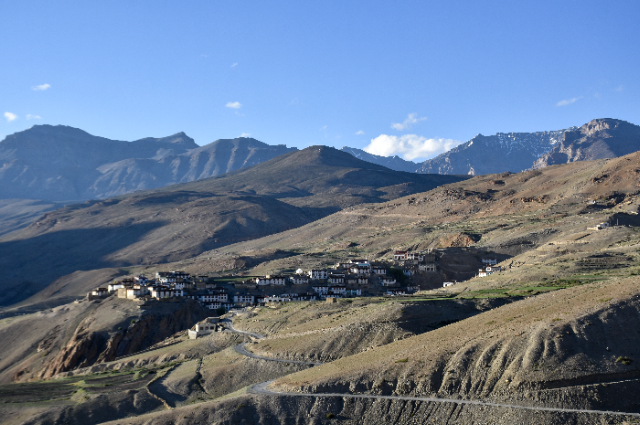India's environmental conservation journey, the United Nations Educational, Scientific and Cultural Organization (UNESCO) has given a remarkable honour upon our nation. The Man and the Biosphere (MAB) Programme's recognition of Himachal Pradesh's ethereal Spiti Valley as India's inaugural Cold Desert Biosphere Reserve represents far more than a ceremonial accolade and it symbolizes a fundamental shift in how we approach the preservation of our nation's most vulnerable ecological treasures.
Understanding the Geographical Canvas
To truly appreciate this achievement, one must first comprehend the sheer magnitude and complexity of what we are protecting. Spanning an expansive 7,770 square kilometres across the Lahaul-Spiti district, this biosphere reserve encompasses terrain that challenges human imagination. Picture, if you will, a landscape where altitudes range from 3,300 metres to a staggering 6,600 metres above sea level where the air grows thin, temperatures plummet to extremes, and precipitation remains perpetually scarce. This is among the coldest and driest inhabited regions on our planet, a cold desert that bears more resemblance to the Tibetan Plateau than to the lush valleys typically associated with the Himalayas.
The reserve's architecture reflects sophisticated conservation planning. It incorporates several already-protected areas including the renowned Pin Valley National Park and Kibber Wildlife Sanctuary, while extending its protective embrace to encompass the shimmering Chandratal Wetland and the stark beauty of the Sarchu Plains. The reserve operates on a thoughtfully designed three-tier system as core zones totalling 2,665 square kilometres where nature reigns supreme with minimal human interference; buffer zones that provide protection; and transition zones where sustainable human activities can coexist with conservation objectives.
With this recognition, India's tally of UNESCO biosphere reserves has climbed to thirteen. However, Spiti holds a distinction that sets it apart it is the first high-altitude cold desert habitat to receive such recognition at this scale within our nation, marking uncharted territory in Indian conservation history.
Opportunities and Responsibilities Ahead
The UNESCO designation opens multiple pathways that we, as a nation must navigate thoughtfully. International collaboration will inevitably increase, bringing with it enhanced funding opportunities, scientific research partnerships, and technical expertise sharing. The global spotlight on Spiti will attract researchers studying everything from climate adaptation mechanisms to sustainable high-altitude development models.
Ecotourism presents both opportunity and peril. Managed responsibly, it can generate crucial revenue streams for local communities while fostering environmental awareness. Managed poorly, it risks degrading the very ecosystems tourists come to experience. We must resist the temptation to view tourism merely as an economic engine and instead recognize it as a tool that requires careful calibration to serve conservation goals.
Principal Chief Conservator of Forests (Wildlife) Amitabh Gautam has rightly noted that this recognition amplifies India's role in the global conservation of fragile Himalayan habitats. It positions us to lead by example in demonstrating how nations can balance development aspirations with ecological imperatives. The Himalayas, often called the "Third Pole" due to their vast ice reserves, face unprecedented challenges from climate change. Spiti's conservation model could offer insights applicable across the entire Himalayan arc and beyond.
Climate Change and the Overarching Challenge
We cannot discuss Spiti's future without confronting the elephant in the room or perhaps more aptly, the warming trend in the mountains. Climate change poses an existential threat to high-altitude ecosystems. Rising temperatures alter precipitation patterns, affect glacial dynamics, shift vegetation zones, and disrupt the delicate ecological relationships that have evolved over millennia.
Cold desert ecosystems like Spiti's are particularly vulnerable because they exist within narrow climatic parameters. Even modest temperature increases can trigger flowing effects throughout the ecosystem. The snow leopards that depend on blue sheep, which in turn depend on specific alpine vegetation, could face population pressures if vegetation zones shift beyond their habitable range.
The biosphere reserve designation provides a framework for systematic monitoring of these changes and developing adaptive management strategies. Research conducted here can inform climate resilience initiatives not just for Spiti but for vulnerable ecosystems globally.
Path Forward: The Lessons and Aspirations
As we celebrate this achievement, we must also accept the weighty responsibilities it entails. The recognition of Spiti Valley as a UNESCO biosphere reserve is not a destination but a departure point and the beginning of a more intentional, internationally supported, and scientifically informed conservation journey.
Several priorities demand our immediate attention. First, we must ensure that local communities remain at the centre of all conservation planning and benefit equitably from the opportunities this designation brings. Their traditional knowledge must be respected, documented, and integrated into management frameworks. Second, we need robust monitoring systems to track ecological health indicators and detect early warning signs of environmental stress. Third, we must develop tourism infrastructure and guidelines that prioritize ecosystem protection over short-term economic gains.
A Moment of National Pride and Global Responsibility
As climate crises intensify globally, the world will be watching Spiti. Will we rise to this challenge? Can we demonstrate that protecting fragile ecosystems while supporting human communities is not merely possible but practical and replicable? The answers to these questions will shape not just Spiti's future but potentially influence conservation approaches worldwide.
In this moment, we should feel both pride and humility pride in this achievement, humility before the responsibilities it imposes. The cold winds that sweep across Spiti carry a message that some places on Earth are too precious, too unique, too irreplaceable to be treated casually. Our recognition of this truth, formalized through UNESCO's designation, marks not an end but a beginning and the start of our commitment to ensuring that future generations inherit a Spiti Valley as wondrous and wild as the one we know today.
The journey ahead demands vigilance, resources, wisdom, and above all, sustained commitment. But if any landscape can inspire such dedication, it is surely the stark, stunning, utterly irreplaceable wilderness of Spiti Valley and India's first Cold Desert Biosphere Reserve and a gift we hold in trust for the world.
. . .
References:

